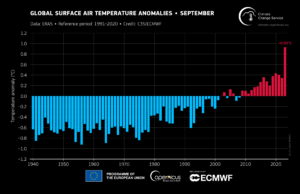Globally September 2023 was the warmest September on record. When combined with this year’s record-breaking summer this puts 2023 on track to be the warmest year on record.
These are the findings for the most recent analysis of the Copernicus Climate Change Service, which routinely publishes monthly climate bulletins reporting on changes observed in global surface air temperature, sea ice cover and hydrological variables. The reported findings are based on computer-generated analyses using billions of measurements from weather stations, aircraft ships and satellites.

Globally averaged surface air temperature anomalies relative to 1991–2020 for each September from 1940 to 2023. Data: ERA5. Credit: C3S/ECMWF.
Global September 2023 – Surface air temperature and sea surface temperature highlights from the Copernicus analysis include:
- September 2023 was the warmest September on record globally, with an average surface air temperature of 16.38°C, 0.93°C above the 1991-2020 average for September and 0.5°C above the temperature of the previous warmest September, in 2020.
- September 2023 global temperature was the most anomalous warm month of any year in the ERA5 dataset (back to 1940).
- The month as a whole was around 1.75°C warmer than the September average for 1850-1900, the pre-industrial reference period.
- The global temperature for January-September 2023 was 0.52°C higher than average, and 0.05°C higher than the equivalent period in the warmest calendar year (2016).
- For January to September 2023, the global mean temperature for 2023 to date is 1.40°C higher than the pre-industrial average (1850-1900).
- For Europe, September 2023 was the warmest September on record, at 2.51°C higher than the 1991-2020 average, and 1.1°C higher than 2020, the previous warmest September.
- The average sea surface temperature for September over 60°S–60°N reached 20.92°C, the highest on record for September and the second highest across all months, behind August 2023.
- El Niño conditions continued to develop over the equatorial eastern Pacific.
More information available on the Copernicus website

Global daily surface air temperature (°C) from 1 January 1940 to 30 September 2023, plotted as time series for each year. 2023 and 2016 are shown with thick lines shaded in bright red and dark red, respectively. Other years are shown with thin lines and shaded according to the decade, from blue (1940s) to brick red (2020s). The dotted line and grey envelope represent the 1.5°C threshold above pre-industrial level (1850–1900) and its uncertainty. Data source: ERA5. Credit: Copernicus Climate Change Service/ECMWF.
Keith Lambkin Head of Climate Services at Met Éireann commented, “What we are currently seeing in the global climate system is unprecedented and the margins by which some records are being set have not been seen before. Ireland, while a small land mass relative to the global, is also experiencing remarkable conditions as evident by Ireland’s weather this summer. June was Ireland’s warmest June on record followed immediately by July, which was Ireland’s wettest July on record. Global climate change affects everyone.”
In the World Meteorological Organization news article the Secretary-General Prof. Petteri Taalas commented, “Since June, the world has experienced unprecedented heat on land and sea. The temperature anomalies are enormous – far bigger than anything we have ever seen in the past. Antarctic winter sea ice extent was the lowest on record for the time of year. What is especially worrying is that the warming El Niño event is still developing, and so we can expect these record-breaking temperatures to continue for months, with cascading impacts on our environment and society”.
Here in Ireland September 2023 was provisionally the 3rd warmest September on record (record length 124 years). Met Éireann’s September Climate Statement is available online.
Irish September highlights include:
- The 4 warmest Septembers in order were 2021, 2006, 2023 and 1941 and these are the only Septembers with a mean temperature at or above 15 °C.
- 24 weather stations reported their highest temperature of the year (only Oak Park, Co Carlow had a higher temperature in June).
- 14 stations broke their September maximum temperature record.
- 10 stations broke their September highest minimum temperature record.
- Heatwaves were reported at 4 stations between Monday 4th and Friday 8th lasting between 5 and 6 days. These were at Mount Dillon, Co Roscommon, Shannon Airport, Co Clare (5 days), Oak Park, Co Carlow and Gurteen, Co Tipperary (6 days).
- Rainfall: Above average nearly everywhere, wettest in the East and South.
Weather stations such as Met Éireann weather stations and those from other National Meteorological Services monitor the weather to strict international standards. When combined together they provide a global snapshot of the weather around the world. If weather stations have been monitoring at the same location for a many decades, they can be used to help determine how the climate has changed over time. It is data such as these weather observations that help inform climate analysis studies.